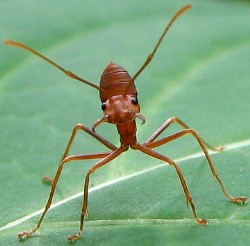 A letter to the editor from Jaboury Ghazoul, in the Jan. 23 issue of Science, tries to put into perspective the $700 billion bailout:
A letter to the editor from Jaboury Ghazoul, in the Jan. 23 issue of Science, tries to put into perspective the $700 billion bailout:
An estimated 10 million species populate the earth. To ward against extinction, we could equitably award $70,000 to each and every one of these 10 million species from our $700 billion cash injection. The intertidal bryozoans of Scotland’s West Coast would alone receive more than $3 million. In Borneo, the 350 or so species of dipterocarp trees could form a union to demand existence rights, using their $25 million to lobby for viable landscape mosaics in which they could persist alongside competing land uses …
Secure · Tax deductible · Takes 45 SecondsSecure · Tax deductible · Takes 45 Seconds
… Should this not be sufficient, they could team up with their obligately resident invertebrates, ensuring that funds would not be restrictive. The 43 species of ants from E. O. Wilson’s single leguminous tree at the Tambopata Reserve in Peru could pool their resources to buy about 150,000 hectares of Amazonian forest (at $20 per hectare). The 163 species of beetles occurring exclusively in the tree species Luehea seemannii could add an additional 570,000 hectares. Even copepods, those diminutive denizens of the deep, would receive just short of $1 billion, yet their ubiquity will ensure that they would have little need of such financial security. Consider though, the jellyfish tree Medusagyne oppositifolia from the Seychelles. Even $70,000 should be enough to save its few remaining individuals, which would no doubt appreciate efforts to promote their populations’ longevities by investing in simple nursery facilities and a modest propagation and planting program. The endangered Indonesian “Pakis ata” fern Lygodium circinnatum would benefit greatly from a $70,000 cash injection toward its conservation through propagation, and $700,000 would go a long way in securing the future of the 10 endangered British insects recently featured on Royal Mail stamps.
Species that are doing just fine, on the other hand, could bank their share of funds. The roughly 7.5 million species not considered at risk could bank their collective $525 billion, hedging their bets against some future need. The interest thereby generated could subsidize species with greater financial and conservation needs and, if reinvested, could maintain the capital stock.
Some species will undoubtedly be declared genetically bankrupt and lost forever, but many more will be offered a lifeline to recovery, flooding the global ecological system with confidence. Growth will be restored.
But where would $700 billion come from? From borrowing, of course. We have been borrowing from Nature’s capital for nigh on the last few centuries — is it not time we paid some back?
For more on insect societies, I highly recommend E.O.Wilson’s The Superorganism: The Beauty, Elegance, and Strangeness of Insect Societies. It’s a fascinating read and also makes a great coffee table book. Insect societies are even stranger than human ones and have many parallels. They have also been around for a lot longer.
Of course, this letter is rhetorical. That $700 billion is an attempt to keep the economic engine of a human society from stalling. That engine was racing out of control, and had it not broken down, it would have burned though its fuel in short order. Getting it started again won’t be easy but maybe, just maybe this time, corporate interests won’t be given control of the governor.
Note also that this money is not providing basic food and shelter for people. It is being used primarily to prop up loans for McMansions, SUVs, cars, boats, RVs, and every other status symbol you can imagine. Are these wants or are they needs?
 A letter to the editor from Jaboury Ghazoul, in the Jan. 23 issue of Science, tries to put into perspective the $700 billion bailout:
A letter to the editor from Jaboury Ghazoul, in the Jan. 23 issue of Science, tries to put into perspective the $700 billion bailout:

